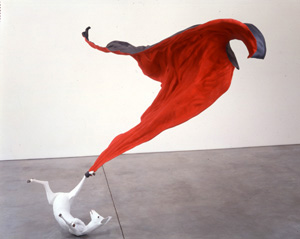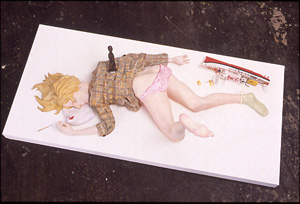October 30, 2003
Artists Swenson, Reid at the MAC

Last night, I went to a panel conversation with David Quadrini, Curator and Owner of Angstrom Gallery and two artists he represents who live here in Dallas: ?Alan Reid, and Eric Swenson.? This discussion was staged at the MAC, a non-profit arts space in downtown Dallas.
David Quadrini was introduced first and he is beloved here in Dallas. He's interesting because he's a curious mix of strengths and weaknessses: passionate, distracted... international, parochial... fashionable, scruffy. He's important because while Dallas has the top end of an arts community well in hand (the major institutional elements), and it has the middle (commercial galleries), it has precious few of the low end (baby artists busting a move with raw exhibition...parties, really). Angstrom Gallery serves as the top of this bottom end, and without David, there really isn't a fermenting youth level for this city. What is too bad and inevitable, is that Angstrom is moving up into the middle zone of established galleries.
Erice's work is reproduced above, carefully crafted and dwelling on nature whilst becoming preternatural, Eric is sweetly incapable of a coherent presentation of his work. His inarticulateness underlines the brilliance of his work, even heightens it vividly. Aw shucks, a look to the floor and a kick of his cowboy boot, he's the real McCoy, a Texan without pretense that I'm sure the international art system thrills to. He's currently being championed by the musems (Ft. Worth, the Whitney) and is hooked up into New York and Swiss galleries. And what is amazing is that all this horsepower is unleashed with three sculptures similar to the one reproduced above one. Later, he tells of a residency at ArtPace in San Antonio, where he busted a different move to the chagrin of the proprieters of ArtPace and the local audience. They wanted another swirling cape and he wanted to make a meditative piece on Shamu the whale... the white lozenges above his eyes abstracted and displayed evoking a minimalist exercise.
Alan Ried by contrast makes work so described by Quadrini:
"...beautiful and horrific death and candy works are remarkable in their use of figurative mannerism and melodrama. Reed creates tragedies that make you laugh." ...which is about right. Or maybe not. It may be his work is funny to his generation as I found myself puzzling over where the humor was. As in this piece:

I didn't find this amusing.
Certainly his work is mannered and melodramatic. He said death was the only subject worth making art about, and I must admit that it is amusing when the twentysomethings dwell on death. Maybe he was depressurizing the gravitas of the subject with a veiled self parody? I hope so.
What makes me record the event in my blog is that at the end of the talk, the floor was open for questions, and I thought I would ask the question that was avoided all night even though it was the pretext of the event (from the invitation: "These artists converse on the challenging question ?what does sculpture mean today??")... I asked them what they thought of the Nasher Museum that has just opened recently with great fanfare. The answer (led by Alan) "I wonder how they clean that funny glass roof?" As they dithered over this detail, it was clear they didn't like the collection, and they awarded the building with slightly higher merit. Clearly they had a critique of the Nasher and it must have been complicated since it looks like the concurrent sculpture show at Angstrom was meant to slipstream the energy of the Nasher opening month.
Not that it's bad to do this. It's smart to suggest that sculpture persists past the datum of the Nasher collection. This collection spans the whole twentieth century with super early Brancusi's and Giacometti's to Serra and Turrell. I asked the artists again (which means Reid since Swenson was too shy) about the aspect of verisimilitude in their work (a word suggested by Quadrini in his introduction, indicating that the work of these younger artists are characterized by representation, or making things that look like other things around them), and this was shrugged off with "I want to make things I didn't see in the galleries around me."
That's a little hard to swallow since sculptors like Charlie Ray are the granddaddies for this generation. It's too bad since I was hoping for an analysis of the scope of making sculpture and the relation of their practice to it. I guess I'm thinking of the work in the Nasher, how munchy and open and free form they are. I was thinking of the relation of drawing to sculture in the Nasher collection, how these other modes of three dimensional forms are closer to sketching or rendering.
(And now images of freinds' work come to mind, sculptors in LA like Bob Therrien, or Greg Colson. They suggest other modes of sculpting.)
And I thought of an earlier formulation of art that I came up with years ago: where, in the high modern moment of abstract expressionism, artists wanted to "touch G-d through physical means", the post-modern turn was to invert this, "touching everyday life through conceptual means"... so, working this formulation around to try to understand this young sculpture: were they trying to touch everyday life with physical means?
http://www.angstromgallery.com/
http://www.the-mac.org/
http://www.nashersculpturecenter.org/index.cfm?FuseAction=Page&PageID=1000000
Posted by Dennis at October 30, 2003 1:50 PM
Leave a comment